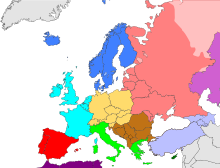Eastern Europe is the eastern region of Europe. Originally, it meant the countries that were under the influence of the Eastern Orthodox Church in Constantinople during the Middle Ages and Western Europe meant those countries following Catholicism or Protestantism. Later, during the Cold War, it meant the European countries that were allied to the Soviet Union. It is now used to talk about the European post-Soviet states and the former Warsaw Pact. Others say that Eastern Europe is a region of mainly Slavic cultures, though other ethnic groups live there as well. Eastern Europe has a large Roma gypsy population.


According to the widest contemporary definitions - including those used by the UN Statistics Division, several other UN organizations and EuroVoc (the multilingual thesaurus of the EU) - the following states are in Eastern Europe:
Partly recognized:
 Abkhazia (part of Western Asia)
Abkhazia (part of Western Asia) Kosovo
Kosovo South Ossetia (part of Western Asia)
South Ossetia (part of Western Asia)
Alternatives
changeSince January 1993 some groups have changed their definitions of Eastern Europe. Although the list above is still the most popular and widely accepted definition of this region, some experts divide the region further into subsections. According to such theories: the Czech Republic, Hungary, Poland and Slovakia are in Central Europe (the western sections of Belarus and Ukraine are also sometimes listed as Central European) or East-Central Europe. Finally, the countries of Albania, Bosnia and Herzegovina, Bulgaria, Croatia, Kosovo, Macedonia, Moldova, Montenegro, Romania and Slovenia are occasionally grouped with a number of other countries into Southern Europe, but more often referred to as Southeast (or Southeastern) Europe.
Other websites
change- Civic Education Trends in Post-Communist Countries of Central and Eastern Europe Archived 2007-01-11 at the Wayback Machine
- Information about Eastern European People Archived 2007-03-11 at the Wayback Machine
- Business portal for Central and Eastern Europe
- Slavic and East European Resources
- The Slavonic and East European Review Archived 2006-10-03 at the Wayback Machine
- The Slavic Review Archived 2006-12-06 at the Wayback Machine